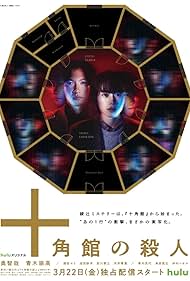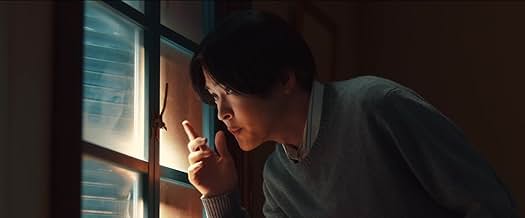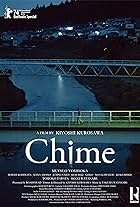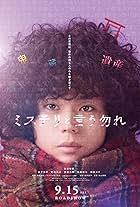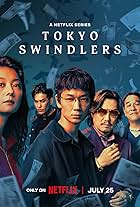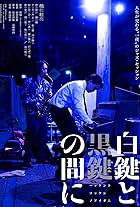After Nakamura Seiji's death, a university research team visits Tsunojima Island for a training camp. Mysterious letters and deaths lead to suspicion and a search for connections.After Nakamura Seiji's death, a university research team visits Tsunojima Island for a training camp. Mysterious letters and deaths lead to suspicion and a search for connections.After Nakamura Seiji's death, a university research team visits Tsunojima Island for a training camp. Mysterious letters and deaths lead to suspicion and a search for connections.
Storyline
Did you know
- TriviaAdapted from the novel "The Decagon House Murders" by Ayatsuji Yukito.
Featured review
Yukito Ayatsuji's "The Decagon House Murders" is one of the defining novels of the so-called shin honkaku school of mystery writing. An intricately constructed closed-circle murder mystery, it is full of references to classic mystery writers, their most famous novels, and favourite cliches of the genre. The plot itself is in fact a sort of a modern riff on Agatha Christie's masterpiece "And Then There Were None" which the characters themselves figure out fairly quickly. The novel was published in 1987 but has never been adapted for the screen before. The reason for this glaring omission is due to the novel's big twist which has until now been deemed as unfilmable.
Now, 37 years later, comes a television mini-series based on the novel which has seemingly come up with a way to film the unfilmable. I wouldn't dare spoil a single line of Ayatsuji's brilliant novel so I'll tread carefully and merely say that the solution the authors of this series have come up with is probably the only one possible. It's far from perfect, it's a little silly, and it makes Ayatsuji's masterful twist much easier to figure out than it is in the novel but I'm just happy someone has finally dared to film the dreaded Decagon House.
The plot follows two parallel mysteries. The first, paraphrasing Christie's novel, sees seven members of the Kyoto Mystery Club visiting a secluded island where a quadruple murder took place just a year before. Of course, before long, the members start getting killed one by one. The second mystery revolves around that very quadruple murder and is investigated by an eager student named Conan (not that one!) and a mysterious amateur sleuth named Shimada.
Much like the novel, even though the two mysteries eventually intersect, the series keeps them separate for most of the runtime. In that spirit, I'll review each in turn.
When I first read the novel, my favourite chapters were the ones set on the island. In the series, the situation is reversed. I'm sorry to say that the island portion of the series is something of a disappointment. For one, the titular Decagon House is nowhere near as scary, hypnotic, and discombobulating as the one described in the novel. The production design makes what should have been a sinister, dilapidated house look like a cosy, aesthetically pleasing sitcom set.
Similarly, the show just doesn't have the horror atmosphere needed to make these scenes work in the way Ayatsuji intended them to. Even though Akira Uchikata's direction is pacy and stylish, it lacks the mood and the suspense of the far superior novel.
I also didn't like the portrayal of the characters on the island. They have unfortunately succumbed to the relatively recent trend on Japanese television of making every single person on screen dress and behave like an anime character. Furthermore, every single young actor in this drama looks like a model instead of a mystery-loving nerd they should be. Especially annoying are the performances from Ayumu Mochizuki who seems physically incapable of keeping still and Yuki Imai whose character is too cartoonish to appear in an episode of "One Piece".
The scenes set on the mainland are thankfully much better. Especially good is the performance of Munetaka Aoki who is simply perfect as the charming oddball Shimada. His chemistry with Tomoya Oku who plays Conan is excellent and their goofy adventures are actually livelier and more entertaining than they were in the novel. I hope that if they decide to adapt any more of Ayatsuji's novels, they keep these two characters as recurring detectives.
And yet, even though it's far from perfect, this mini-series is a valiant attempt to tackle an unfilmable novel. The big twist does not work as well as it did in the novel but I doubt anyone could come up with a better way to film it. The performances are over-the-top but the story is still as engrossing and fiendishly complicated as ever.
More than anything else, I have to commend the adaptation by Kaori Fujii, Madoka Hayano and Hiroyuki Yatsu. They succeed in turning the talky, exposition-heavy novel into a well-paced, dynamic, and consistently entertaining mini-series without altering the plot in the least. This is an extremely faithful adaptation of the Ayatsuji novel and it is a delightful surprise that it works as well as it does on screen.
In the end, I did enjoy this adaptation but I cannot stress enough that if you are a fan of mystery fiction you absolutely should read the novel first.
Now, 37 years later, comes a television mini-series based on the novel which has seemingly come up with a way to film the unfilmable. I wouldn't dare spoil a single line of Ayatsuji's brilliant novel so I'll tread carefully and merely say that the solution the authors of this series have come up with is probably the only one possible. It's far from perfect, it's a little silly, and it makes Ayatsuji's masterful twist much easier to figure out than it is in the novel but I'm just happy someone has finally dared to film the dreaded Decagon House.
The plot follows two parallel mysteries. The first, paraphrasing Christie's novel, sees seven members of the Kyoto Mystery Club visiting a secluded island where a quadruple murder took place just a year before. Of course, before long, the members start getting killed one by one. The second mystery revolves around that very quadruple murder and is investigated by an eager student named Conan (not that one!) and a mysterious amateur sleuth named Shimada.
Much like the novel, even though the two mysteries eventually intersect, the series keeps them separate for most of the runtime. In that spirit, I'll review each in turn.
When I first read the novel, my favourite chapters were the ones set on the island. In the series, the situation is reversed. I'm sorry to say that the island portion of the series is something of a disappointment. For one, the titular Decagon House is nowhere near as scary, hypnotic, and discombobulating as the one described in the novel. The production design makes what should have been a sinister, dilapidated house look like a cosy, aesthetically pleasing sitcom set.
Similarly, the show just doesn't have the horror atmosphere needed to make these scenes work in the way Ayatsuji intended them to. Even though Akira Uchikata's direction is pacy and stylish, it lacks the mood and the suspense of the far superior novel.
I also didn't like the portrayal of the characters on the island. They have unfortunately succumbed to the relatively recent trend on Japanese television of making every single person on screen dress and behave like an anime character. Furthermore, every single young actor in this drama looks like a model instead of a mystery-loving nerd they should be. Especially annoying are the performances from Ayumu Mochizuki who seems physically incapable of keeping still and Yuki Imai whose character is too cartoonish to appear in an episode of "One Piece".
The scenes set on the mainland are thankfully much better. Especially good is the performance of Munetaka Aoki who is simply perfect as the charming oddball Shimada. His chemistry with Tomoya Oku who plays Conan is excellent and their goofy adventures are actually livelier and more entertaining than they were in the novel. I hope that if they decide to adapt any more of Ayatsuji's novels, they keep these two characters as recurring detectives.
And yet, even though it's far from perfect, this mini-series is a valiant attempt to tackle an unfilmable novel. The big twist does not work as well as it did in the novel but I doubt anyone could come up with a better way to film it. The performances are over-the-top but the story is still as engrossing and fiendishly complicated as ever.
More than anything else, I have to commend the adaptation by Kaori Fujii, Madoka Hayano and Hiroyuki Yatsu. They succeed in turning the talky, exposition-heavy novel into a well-paced, dynamic, and consistently entertaining mini-series without altering the plot in the least. This is an extremely faithful adaptation of the Ayatsuji novel and it is a delightful surprise that it works as well as it does on screen.
In the end, I did enjoy this adaptation but I cannot stress enough that if you are a fan of mystery fiction you absolutely should read the novel first.
Details
- Release date
- Country of origin
- Official site
- Language
- Also known as
- The Decagon House Murders
- See more company credits at IMDbPro
- Color
Contribute to this page
Suggest an edit or add missing content

Top Gap
By what name was Jukkakukan no satsujin (2024) officially released in Canada in English?
Answer